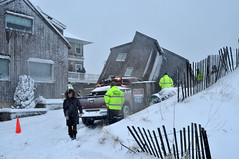 As yet another brutal winter storm hammers Massachusetts with snow, wind and coastal erosion, there's a lot of talk about what a rough winter it's been in Massachusetts. But our temperatures have actually been mild, and climate scientists say this type of winter is exactly what we can expect in a warming world.
As yet another brutal winter storm hammers Massachusetts with snow, wind and coastal erosion, there's a lot of talk about what a rough winter it's been in Massachusetts. But our temperatures have actually been mild, and climate scientists say this type of winter is exactly what we can expect in a warming world.First, the temperature data from NOAA's National Weather Service Boston office:
- Boston: December: +3.7, January +2.5, February -0.5, March (thru 3/6): +2.5
- Worcester: December: +4.7, January: +2.7, February +0.4, March: +1.5
- Providence: December +4.1, January: +2.1, February: -1.0, March: +3.0
The National Wildlife Federation reports climate change is bringing more oddball winter weather:
Global warming is bringing a clear trend toward heavier precipitation events for the simple reason that warmer air can hold more water. Even with a greater fraction of precipitation falling as rain, many areas are still seeing big and intense snowstorms, especially in the upper Midwest and Northeast, where temperatures typically remain below freezing in winter. At the same time, global warming is shifting storm tracks northward. The last few years have brought several unusually heavy snowstorms as warmer and moister air over southern states has penetrated further north, colliding with bitter cold air masses.As ClimateCentral.org's Andrew Freedman details, this winter storm has also highlighted the impacts of global warming-fueled sea level rise:
Higher sea levels provide a higher launching pad for storm surges from hurricanes and nor’easters, making it possible for relatively weak storms to cause major damage.In a sane world, cutting carbon pollution and building out clean energy would be at the top of our national agenda. Instead, Congressional Republican leadership is committed to creating one new phony crisis after another, trying to decide whether to punish the old, sick, young, or all of the above as they fight to protect tax cuts for the wealthiest Americans and oil executives.
According to research by Climate Central scientists, on Nantucket Island, where coastal flooding is occurring from this storm, the sea level has risen by about half a foot during the past 50 years.
According to the draft National Climate Assessment report released in January, even without any changes in storms, the chance of what is now a 1-in-10-year coastal flood event in the Northeast could triple by 2100, occurring once every 3 years, due to rising sea levels.
Fortunately, President Obama doesn't have to wait for Congress to act - he has authority under the Clean Air Act to limit industrial carbon pollution. Tell President Obama you want the strongest limits possible - and if you want to do even more, join Reality Drop.

No comments:
Post a Comment